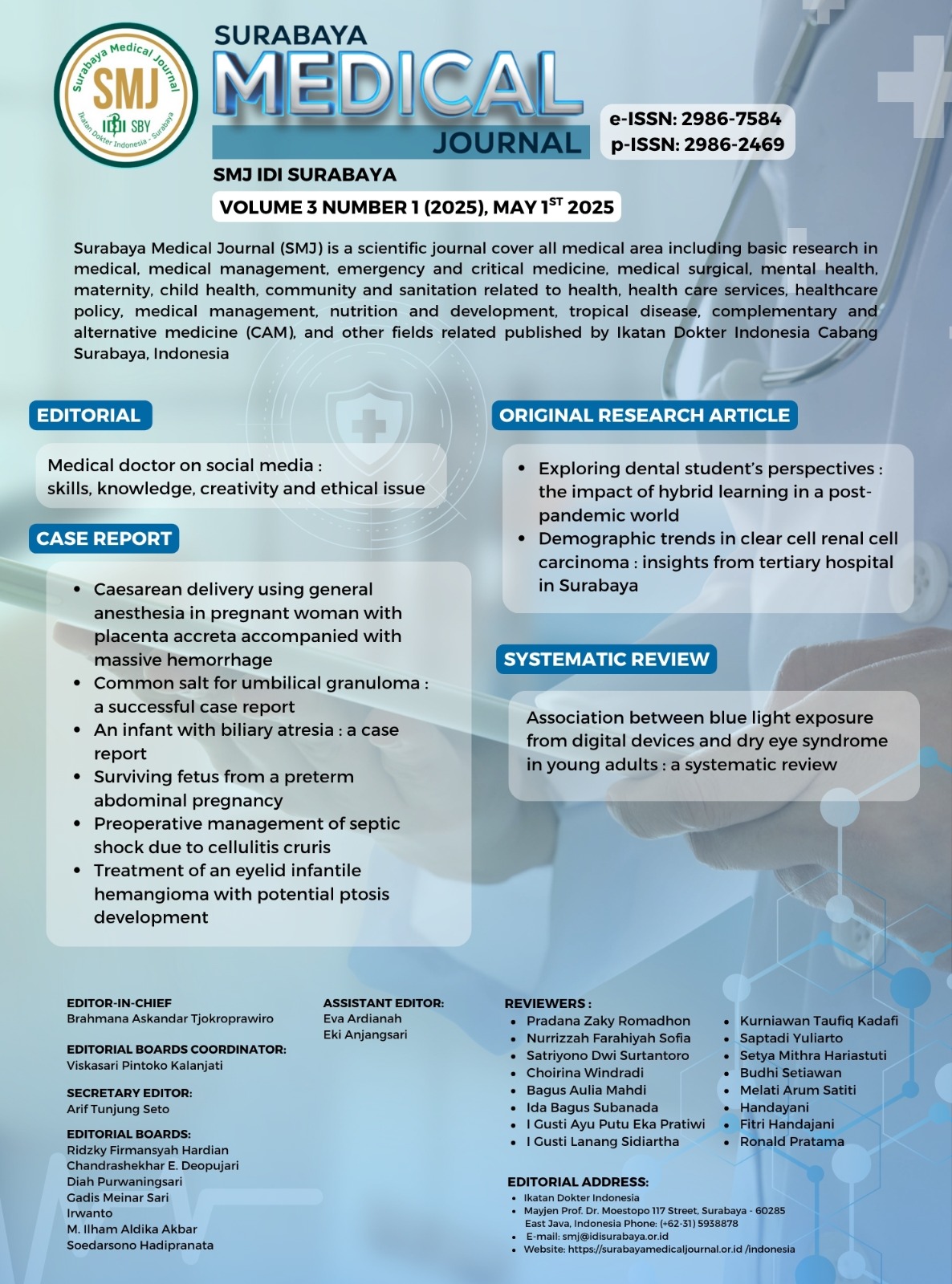Association between blue light exposure from digital devices and dry eye syndrome in young adults: a systematic review
Blue light exposure and DES
DOI:
https://doi.org/10.59747/smjidisurabaya.v3i1.97Keywords:
Blue light, digital devices, dry eye syndrome, Young Adults, Systematic ReviewAbstract
Background: The rise in digital device usage has amplified exposure to blue light, raising concerns regarding its impact on ocular health, particularly in relation to dry eye syndrome (DES). This systematic review aims to assess the association between blue light exposure and DES severity among young adults, with a focus on studies demonstrating significant findings and minimal risk of bias. Objective: This review examines the impact of blue light exposure on DES in young adults, focusing on symptom severity and the potential benefits of blue light filters. Material and Method: A comprehensive search was conducted in PubMed, Scopus, and Google Scholar, covering the period from 2015 to 2025. Out of 20 identified studies, eight met the inclusion criteria. Data extraction focused on blue light exposure, DES assessment, and effect sizes. Risk of bias was evaluated using the Newcastle-Ottawa Scale (NOS). Conclusion: Blue light exposure is significantly associated with increased DES symptoms in young adults. Implementing screen time management strategies and blue light filters may mitigate ocular surface damage. Further longitudinal studies are necessary to validate preventive strategies and assess long-term outcomes.
References
Akhtar, S., Rahman, M., Khan, A., 2023. The Effectiveness of Blue Light Filters in Reducing Digital Eye Strain. J. Ophthalmol. Res. 9, 84–91.
Alam, M., Abbas, K., Sharf, Y., Khan, S., 2024. Impacts of Blue Light Exposure From Electronic Devices on Circadian Rhythm and Sleep Disruption in Adolescent and Young Adult Students. Chronobiol. Med. 6, 10–14.
Alqurashi, A., Almaghrabi, H., Alahmadi, M., Alotaibi, A., Alotaibi, B., Jastaniah, A., Bukhari, A., Binhussein, M., Othman, B., Khojah, A., 2024. The Severity of Dry Eye Symptoms and Risk Factors Among University Students in Saudi Arabia: A Cross-Sectional Study. Sci. Rep. 14, 1–6.
Baudouin, C., Aragona, P., Messmer, E.M., Tomlinson, A., Calonge, M., Boboridis, K.G., Akova, Y.A., Geerling, G., Labetoulle, M., Rolando, M., 2013. Role of hyperosmolarity in the pathogenesis and management of dry eye disease: Proceedings of the ocean group meeting. Ocul. Surf. 11, 246–258.
Chen, H., Liu, Z., Wong, A., 2023. Impact of Blue Light Filters on Tear Film Stability: A Case-Control Study. Clin. Exp. Ophthalmol. 27, 389–395.
Cougnard-Gregoire, A., Merle, B.M.J., Aslam, T., Seddon, J.M., Aknin, I., Klaver, C.C.W., Garhöfer, G., Layana, A.G., Minnella, A.M., Silva, R., Delcourt, C., 2023. Blue Light Exposure: Ocular Hazards and Prevention—A Narrative Review. Ophthalmol. Ther. 12, 755–788.
Faruqui, S., Agarwal, R., Kumar, R., 2023. Smartphone Usage and Dry Eye: A Coss Sectional Study Among Medical Students. J. Clin. Res. 12, 245–252.
Gu, Y., Cao, K., Li, A., Wang, J., Guo, Y., Hao, Y., Tian, L., Jie, Y., 2024. Association between sleep quality and dry eye disease: a literature review and meta-analysis. BMC Ophthalmol. 24, 1–10.
Ham, W.T., Ruffolo, J.J., Mueller, H.A., Clarke, A.M., Moon, M.E., 1978. Hystologic analysis of photochemical lesions produced in rhesus retina by short-wave-length light. Invest. Ophthabnol. Vis. Sci. 17, 1029–1035.
Hanyuda, A., Sawada, N., Uchino, M., Kawashima, M., Yuki, K., Tsubota, K., Tanno, K., Sakata, K., Yamagishi, K., Iso, H., Yasuda, N., Saito, I., Kato, T., Abe, Y., Arima, K., Shimazu, T., Yamaji, T., Goto, A., Inoue, M., Iwasaki, M., Tsugane, S., 2021. Relationship between unhealthy sleep status and dry eye symptoms in a Japanese population: The JPHC-NEXT study. Ocul. Surf. 21, 306–312.
Kaido, M., Toda, I., Oobayashi, T., Kawashima, M., Katada, Y., Tsubota, K., 2016. Reducing short-wavelength blue light in dry eye patients with unstable tear film improves performance on tests of visual acuity. PLoS One 11, 1–10.
Kaur, K., Gurnani, B., Nayak, S., Deori, N., Kaur, S., Jethani, J., Singh, D., Agarkar, S., Hussaindeen, J.R., Sukhija, J., Mishra, D., 2022. Digital Eye Strain - A Comprehensive Review. Ophthalmol. Ther. 11, 1655–1680.
Khan, S., Pant, K., Ali, J., Abedin, Z., Kumari, R., Gupta, S.K., 2025. Impact of blue light exposure on the ocular structures and its preventive measures or management options. EPRA Int. J. Res. Dev. 10.
Lee, W., Lim, S.S., Won, J.U., Roh, J., Lee, J.H., Seok, H., Yoon, J.H., 2015. The association between sleep duration and dry eye syndrome among Korean adults. Sleep Med. 16, 1327–1331.
Lee, Y.B., Koh, J.W., Hyon, J.Y., Wee, W.R., Kim, J.J., Shin, Y.J., 2014. Sleep deprivation reduces tear secretion and impairs the tear film. Investig. Ophthalmol. Vis. Sci. 55, 3525–3531.
Lemp, M.A., Baudouin, C., Baum, J., Dogru, M., Foulks, G.N., Kinoshita, S., Laibson, P., McCulley, J., Murube, J., Pflugfelder, S.C., Rolando, M., Toda, I., 2007. The definition and classification of dry eye disease: Report of the definition and classification subcommittee of the international Dry Eye WorkShop (2007). Ocul. Surf. 5, 75–92.
Li, A., Zhang, X., Guo, Y., Wang, J., Hao, Y., Gu, Y., Jie, Y., 2022. The Association Between Dry Eye and Sleep Disorders: The Evidence and Possible Mechanisms. Nat. Sci. Sleep 14, 2203–2212.
Li, S., Ning, K., Zhou, J., Guo, Y., Zhang, H., Zhu, Y., Zhang, L., Jia, C., Chen, Y., Sol Reinach, P., Liu, Z., Li, W., 2018. Sleep deprivation disrupts the lacrimal system and induces dry eye disease. Exp. Mol. Med. 50, e451-12.
Lockley, S.W., Evans, E.E., Scheer, F.A.J.L., Brainard, G.C., Czeisler, C.A., Aeschbach, D., 2006. Short-wavelength sensitivity for the direct effects of light on alertness, vigilance, and the waking electroencephalogram in humans. Sleep 29, 161–168.
Martinez, L., Garcia, T., Lopez, M., 2024. Prolonged Device Usage and Dry Eye Syndrome: A Cohort Study. J. Ophthalmol. Sci. 16, 102–110.
Mure, L.S., 2021. Intrinsically Photosensitive Retinal Ganglion Cells of the Human Retina. Front. Neurol. 12, 1–10.
Nguyen, P., Tran, L., Hoang, V., 2020. Digital Eye Strain and Smartphone Usage Among Young Adults. Int. J. Ophthalmol. 19, 67–74.
Nichols, K.K., 2006. Patient-reported symptoms in dry dye disease. Ocul. Surf. 4, 137–145.
Ouyang, X., Yang, J., Hong, Z., Wu, Y., Xie, Y., Wang, G., 2020. Mechanisms of blue light-induced eye hazard and protective measures: a review. Biomed. Pharmacother. 130, 110577.
Tanaka, Y., Saito, M., Kudo, T., 2025. The Efficacy of Blue Light Filters in Reducing Digital Eye Strain: A Randomized Controlled Trial. J. Ophthalmic Reasearch 30, 112–119.
Wei, Y., Asbell, P.A., 2014. The core mechanism of dry eye disease is inflammation. Eye Contact Lens 40, 248–256.
Wolffsohn, J.S., Wang, M.T.M., Vidal-Rohr, M., Menduni, F., Dhallu, S., Ipek, T., Acar, D., Recchioni, A., France, A., Kingsnorth, A., Craig, J.P., 2021. Demographic and lifestyle risk factors of dry eye disease subtypes: A cross-sectional study. Ocul. Surf. 21, 58–63.
Yan, Y., Wu, Y., Zhao, Y., Yang, Y., An, G., Liu, Z., Qi, D., 2025. A review on eye diseases induced by blue light: pathology, model, active ingredients and mechanisms. Front. Pharmacol. 16.
Yang, P.L., Tsujimura, S. ichi, Matsumoto, A., Yamashita, W., Yeh, S.L., 2018. Subjective time expansion with increased stimulation of intrinsically photosensitive retinal ganglion cells. Sci. Rep. 8, 1–9.
Zhao, Z.C., Zhou, Y., Tan, G., Li, J., 2018. Research Progress About The Effect and Prevention of Blue Light On Eyes. Int. J. Ophthalmol. 11, 1999–2003.
Downloads
Published
Issue
Section
Categories
License
Copyright (c) 2025 Maria Evane Navy Cahaya Putri, Empi Irawan

This work is licensed under a Creative Commons Attribution 4.0 International License.














